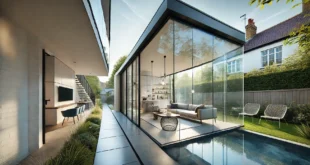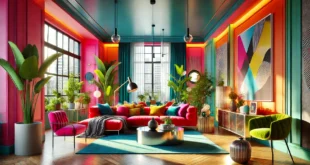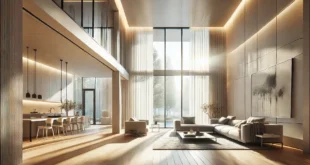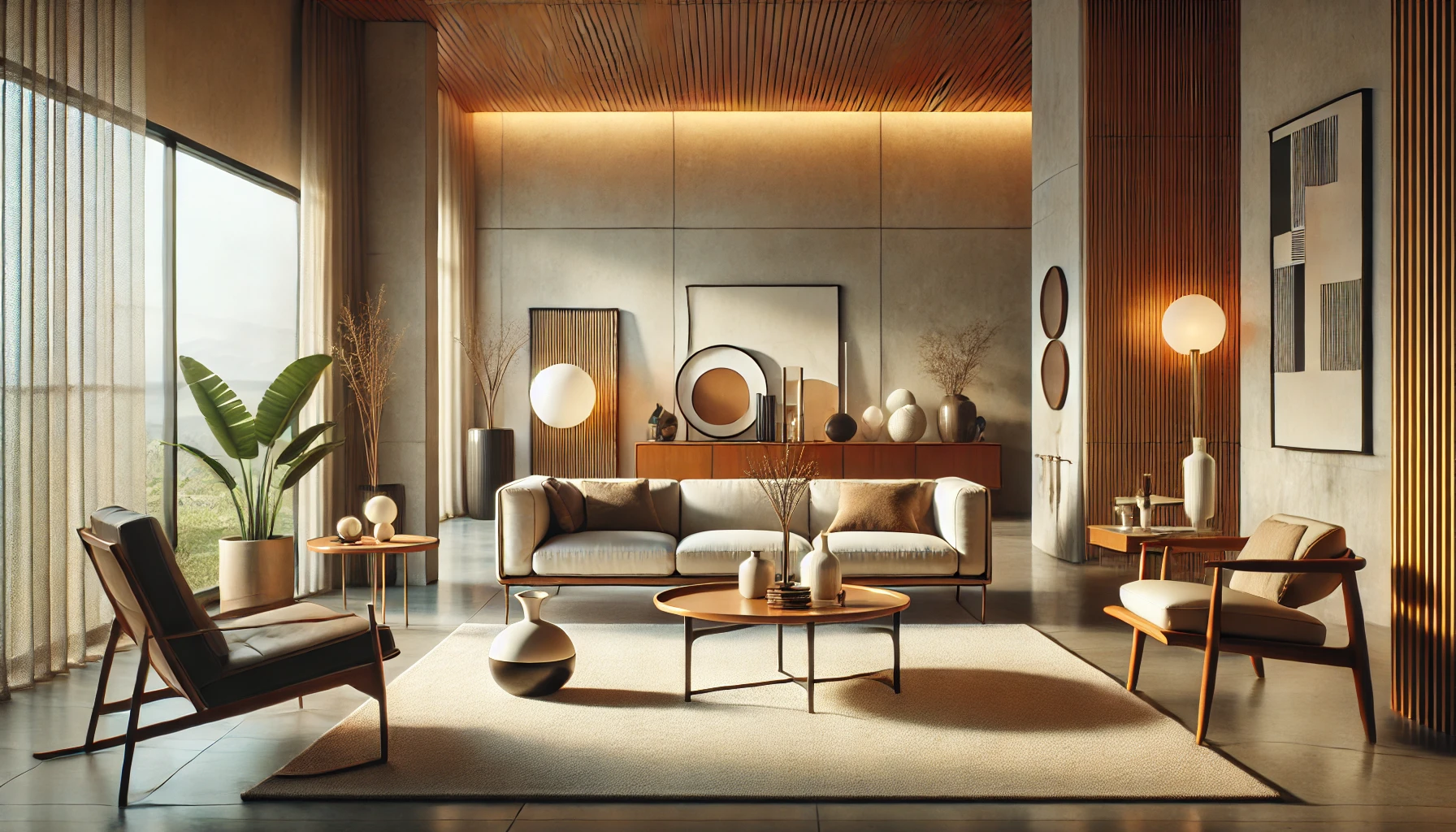
Welcome to a journey through the captivating world of mid-century modern design. If you’re a homeowner, designer, or simply someone who appreciates classic aesthetics, you’re in the right place. Today, we’ll explore one of the most iconic styles in interior design history—mid-century modern. Whether you’re looking to upgrade your living space or inspire your next project, this guide will offer valuable insights into what makes mid-century modern design stand out. Not only will you learn about its distinct features, but you’ll also discover how to incorporate this timeless style into your home effortlessly. Ready to elevate your space with clean lines, organic curves, and retro charm? Let’s get started!
What is Mid-century Modern Interior Design?
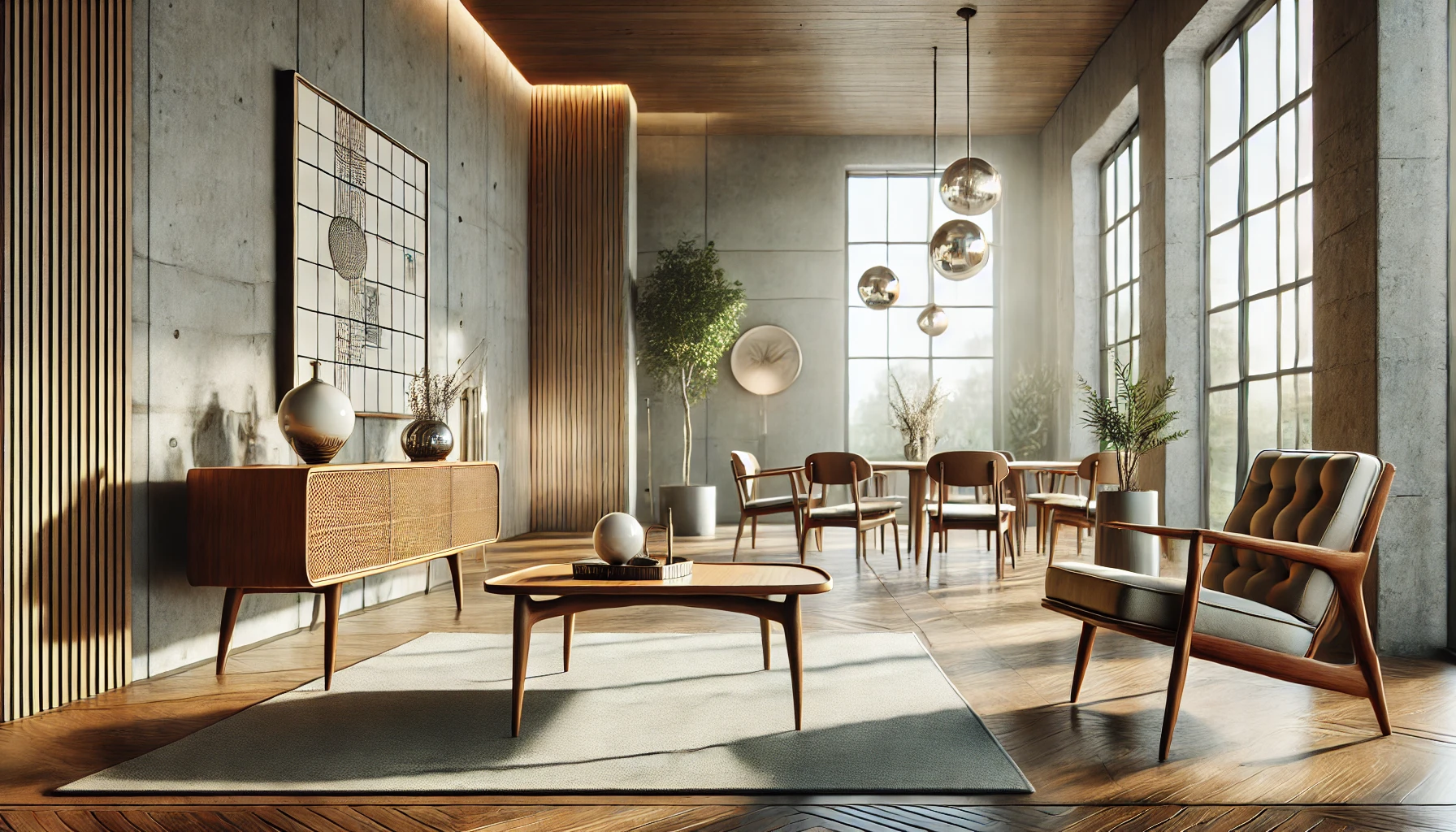
The Origins of Mid-century Modern
Mid-century modern design emerged in the mid-20th century, reflecting a blend of post-war optimism and innovation. It is characterized by clean lines, functional forms, and an emphasis on simplicity. This design style became popular in the 1950s and ’60s, offering a fresh and futuristic look while still retaining natural elements.
The origins of mid-century modern design are rooted in the works of prominent designers like Charles and Ray Eames. Their innovative furniture designs helped shape what we now know as mid-century modern. With its blend of modernism and comfort, this design style continues to influence contemporary interiors.
Why is Mid-century Modern Interior Design So Popular?
One reason mid-century modern remains so popular is its timeless appeal. The style is both functional and aesthetically pleasing, making it ideal for modern homes. Its versatility allows it to work well with other design elements, blending seamlessly into various settings while still standing out.
Moreover, mid-century modern design emphasizes open spaces and natural light, which aligns with current trends in sustainable living and eco-friendly design. Its focus on simplicity and practicality resonates with people seeking a minimalist yet stylish home environment.
Key Features of Mid-century Modern Furniture
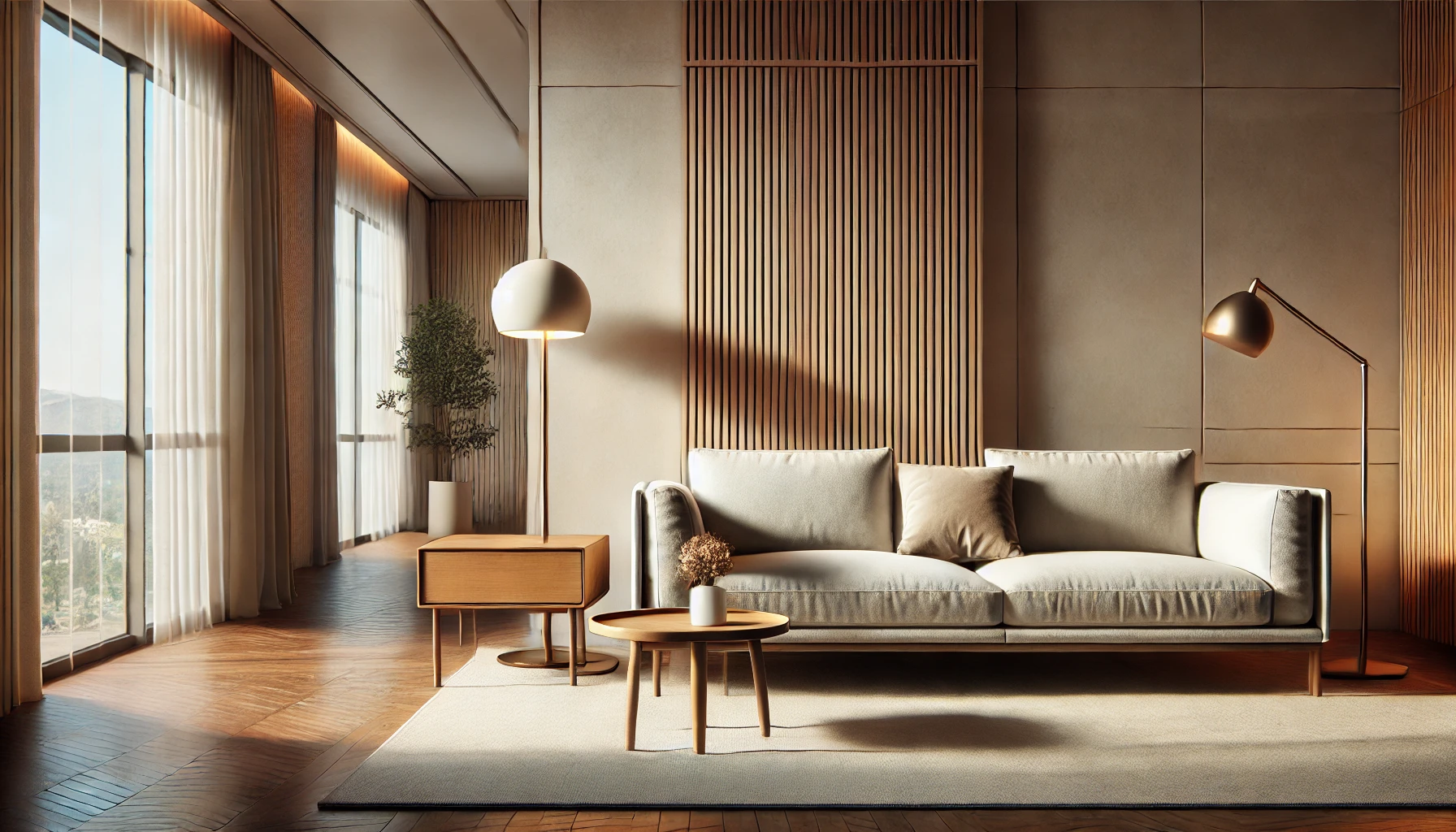
Simplicity and Functionality in Design
Mid-century modern furniture is known for its simple, yet functional designs. Clean lines, geometric shapes, and minimal ornamentation define the aesthetic. Designers aimed to create pieces that were both beautiful and practical, ensuring that each item served a clear purpose.
Furniture in this style often includes natural materials such as wood, leather, and metal, combined with innovative techniques that reflect a forward-thinking approach. This simplicity is why mid-century modern pieces remain relevant and highly sought after today.
Organic and Geometric Shapes
Another hallmark of mid-century modern furniture is its use of organic and geometric shapes. Furniture pieces often feature curves that mimic natural forms, offering a soft contrast to the sharp lines often seen in modern design. This fusion of organic and geometric elements creates a harmonious balance in any room.
From iconic egg chairs to tapered wooden legs, these designs remain timeless due to their ability to balance form with function. Whether you’re furnishing a living room, bedroom, or office, mid-century modern furniture provides both comfort and style.
Incorporating Mid-century Modern Living Room Ideas
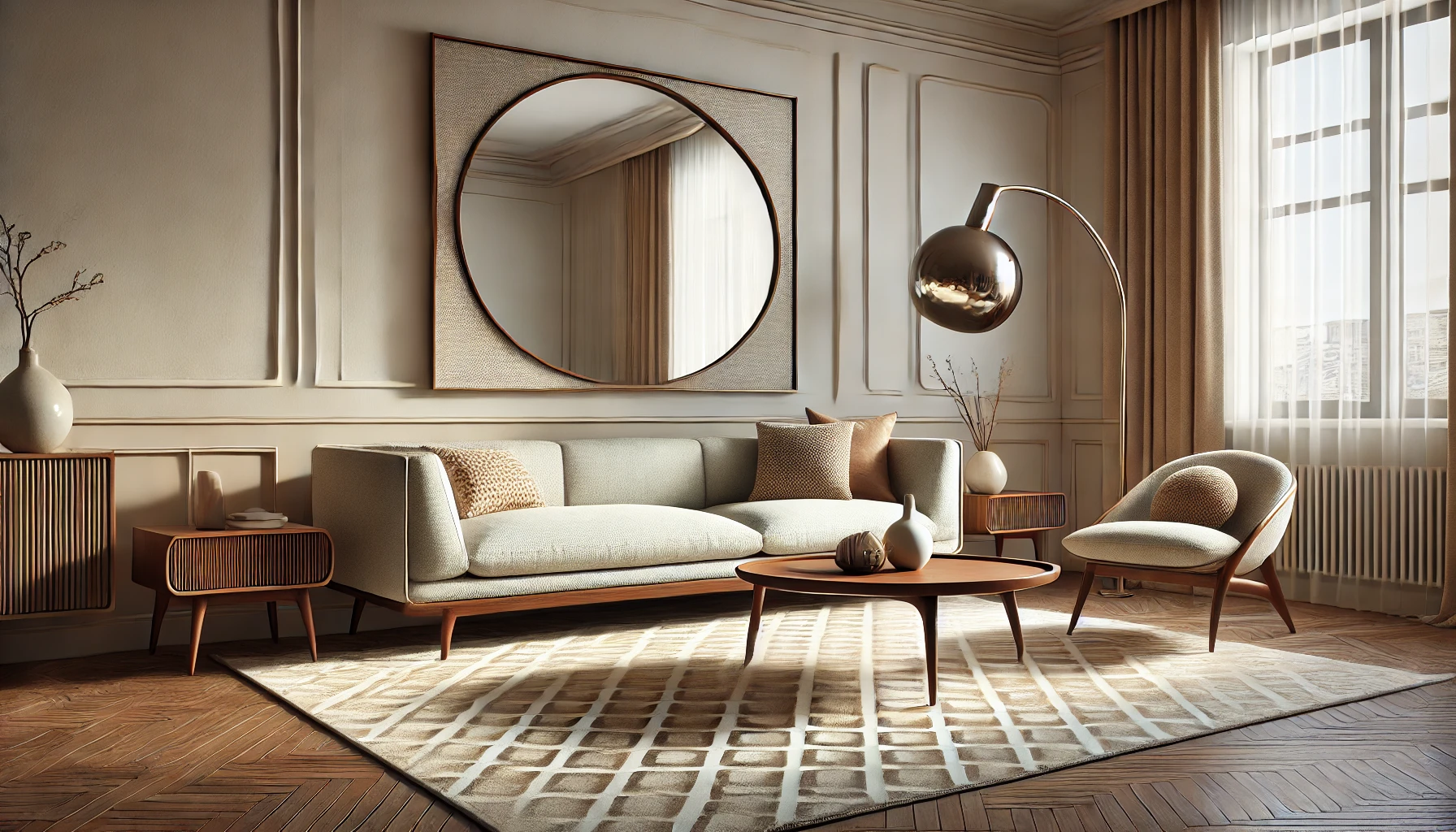
Choosing the Right Furniture
When incorporating mid-century modern design into your living room, start with key furniture pieces. Look for sofas and chairs with clean lines and neutral colors like beige, grey, or white. These colors complement the natural materials often used in mid-century furniture, such as wood and leather.
A simple yet stylish coffee table with wooden legs can serve as the focal point of the room. Remember, less is more in mid-century modern design, so avoid cluttering the space with unnecessary items.
Adding Mid-century Modern Accessories
Accessorizing your living room is another way to bring in mid-century modern vibes. Consider adding a statement rug with geometric patterns or an oversized mirror with a wooden frame. The key is to keep the room balanced—minimal but impactful.
Lighting also plays a crucial role in creating the right ambiance. Choose lamps with sleek designs, preferably with metallic or wooden bases. A classic arc floor lamp can be both functional and visually striking.
Exploring Mid-century Modern Home Decor
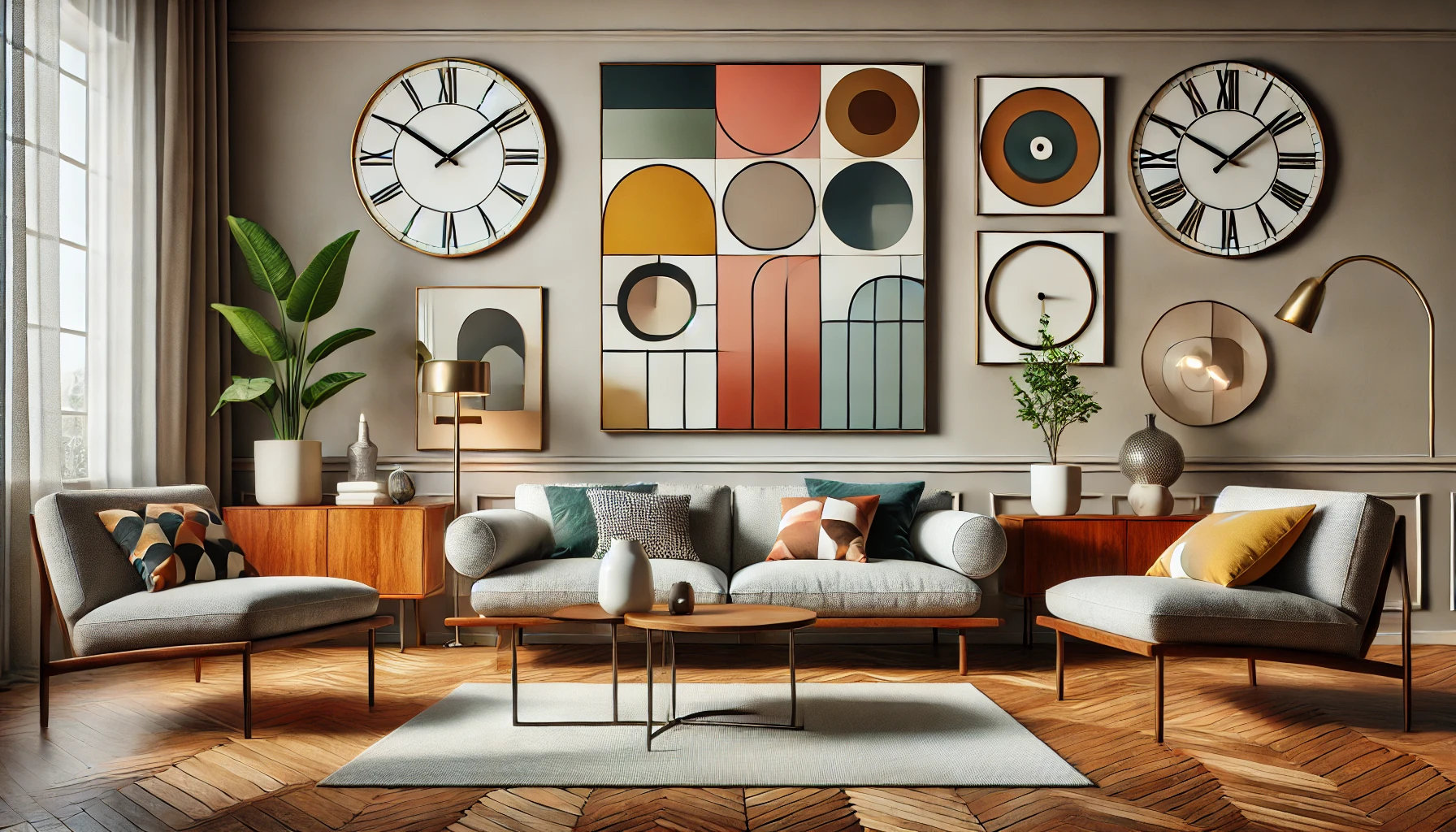
Mid-century Art and Wall Decor
Wall art is a great way to enhance mid-century modern home decor. Opt for abstract art with bold colors and geometric shapes. These pieces can provide a pop of color and serve as a focal point for any room.
Another option is to use wall mirrors or clocks with minimalist designs. These items not only serve a practical purpose but also add to the aesthetic of the space. Their clean lines and understated elegance are in keeping with the mid-century modern ethos.
Mixing Vintage and Contemporary Pieces
Mid-century modern decor works well when mixed with both vintage and contemporary pieces. This allows you to personalize the space while maintaining a cohesive design. Vintage furniture, especially authentic mid-century pieces, can add character and authenticity to your home.
Meanwhile, contemporary items like throw pillows, rugs, and lighting fixtures can give the room a fresh, modern twist. The key is balance—mixing old and new in a way that complements each other without overwhelming the space.
Understanding Mid-century Modern Architecture
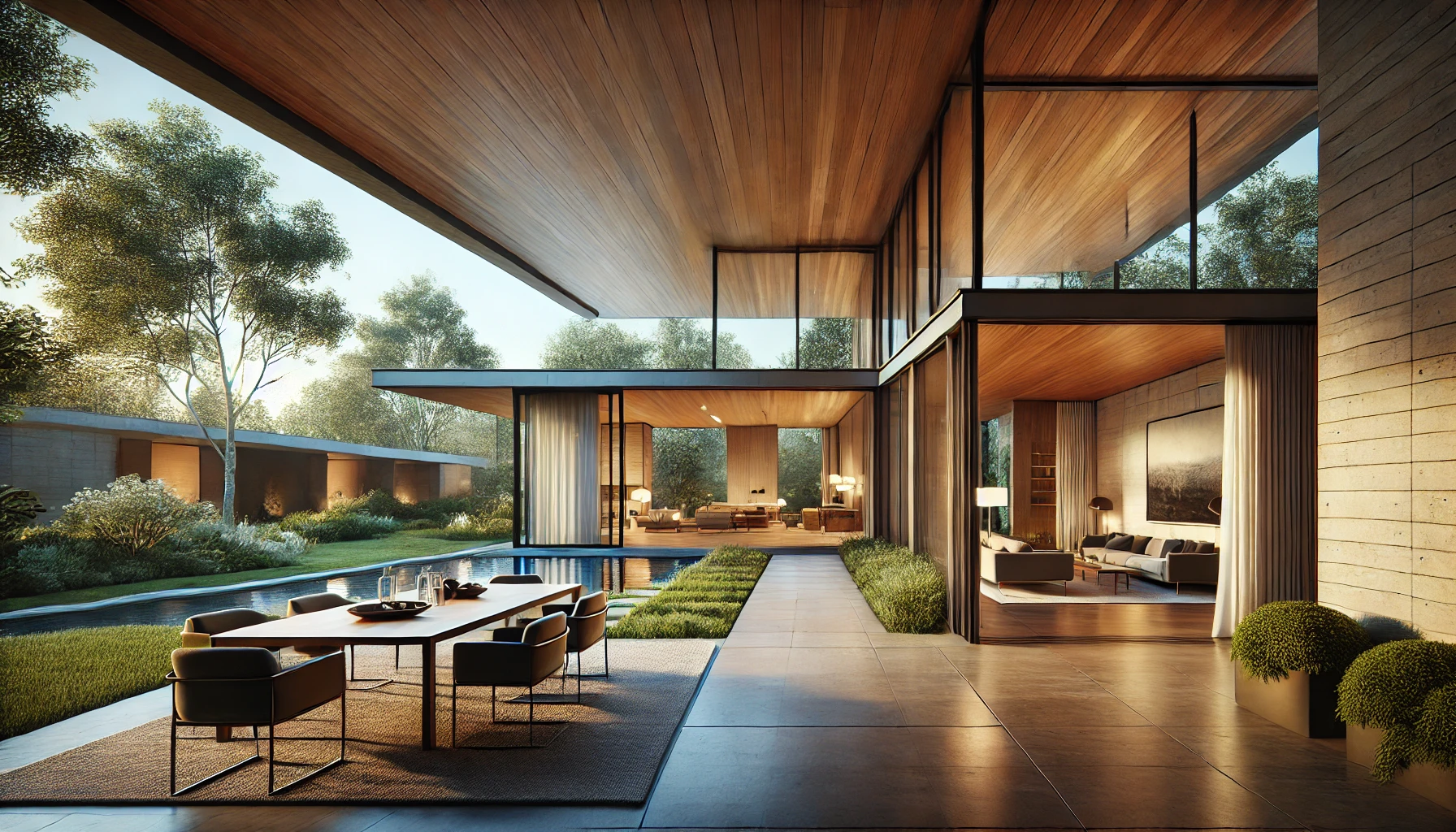
Characteristics of Mid-century Modern Homes
Mid-century modern architecture is characterized by its emphasis on open spaces, large windows, and natural materials. These homes often feature flat planes, large glass windows, and open floor plans that encourage a seamless flow between indoors and outdoors.
The use of natural materials like wood, stone, and brick is another defining feature. These elements create a sense of warmth and balance the sleek, minimalist look of mid-century modern homes.
Bringing the Outdoors In
One of the key principles of mid-century modern architecture is the integration of nature into the living space. Large windows, sliding glass doors, and open floor plans blur the line between indoor and outdoor areas, making the most of natural light.
This connection with nature is not only visually appealing but also creates a calming and tranquil atmosphere. Whether you live in a suburban home or a city apartment, bringing the outdoors in can enhance your living environment.
Mid-century Modern Color Palette
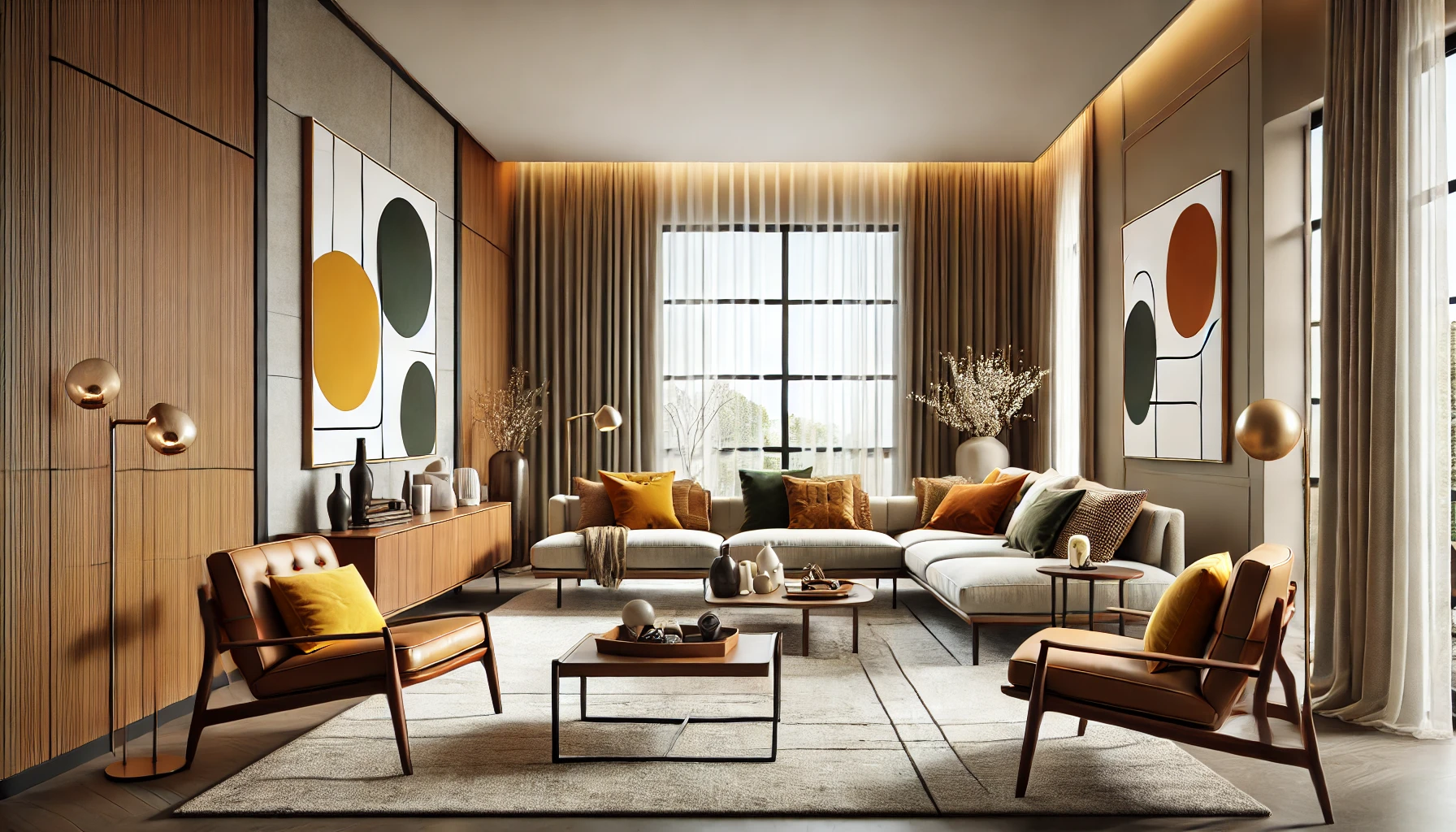
Neutral Tones and Earthy Colors
When it comes to the mid-century modern color palette, neutral tones and earthy colors dominate. Think shades of beige, brown, white, and gray. These colors create a warm and inviting atmosphere, complementing the natural materials used in mid-century modern furniture and decor.
Accent colors like mustard yellow, olive green, and burnt orange can be used sparingly to add a pop of color. These hues are reminiscent of the 1950s and ’60s, giving your space a nostalgic yet modern feel.
Incorporating Bold Accent Colors
While neutral tones form the base of mid-century modern design, bold accent colors can bring energy and personality to the space. You can introduce these colors through throw pillows, rugs, or artwork, ensuring they don’t overwhelm the room.
By carefully selecting accent pieces in bold colors, you can create a dynamic look that feels both retro and contemporary. The key is to strike the right balance between neutral and bold elements.
Mid-century Modern Bedroom Ideas
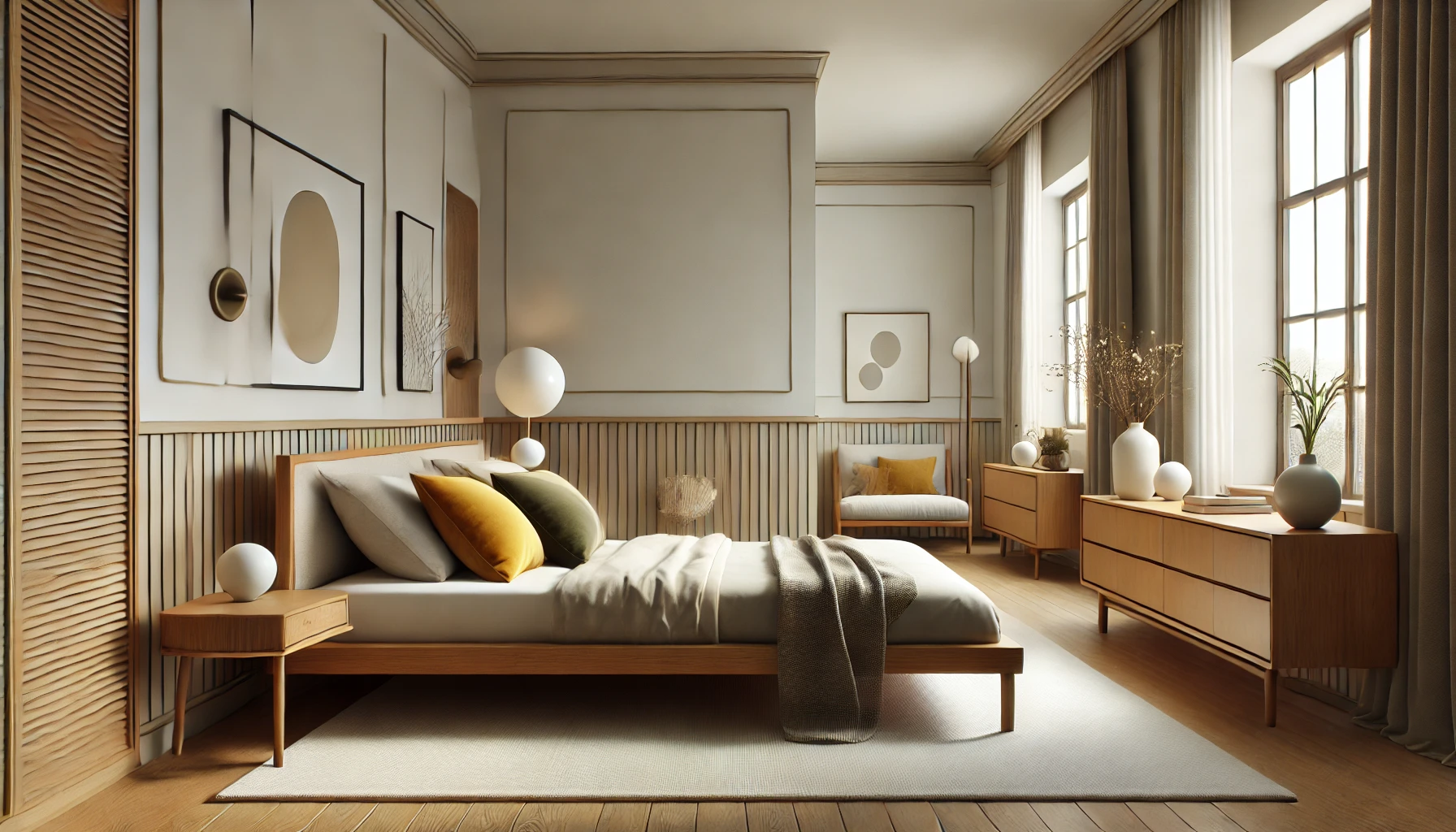
Furniture and Layout
Creating a mid-century modern bedroom involves selecting the right furniture and layout. Opt for a simple, low-profile bed frame made from wood or metal. Complement this with minimalist nightstands and a sleek dresser to keep the space functional and stylish.
The layout should focus on maximizing open space, with furniture placed thoughtfully to maintain a clean and uncluttered look. Mid-century modern design is all about simplicity and practicality, so every piece should have a purpose.
Mid-century Modern Bedding and Textiles
When it comes to bedding, opt for neutral colors and simple patterns. Textiles in mid-century modern bedrooms should be soft and inviting while maintaining a minimalist look. Stick to solid colors or subtle geometric patterns for a cohesive design.
Adding a few accent pillows in bold colors can bring a touch of retro charm to the room. The key is to keep the space feeling light and airy, with a focus on comfort and simplicity.
Mid-century Modern Lighting
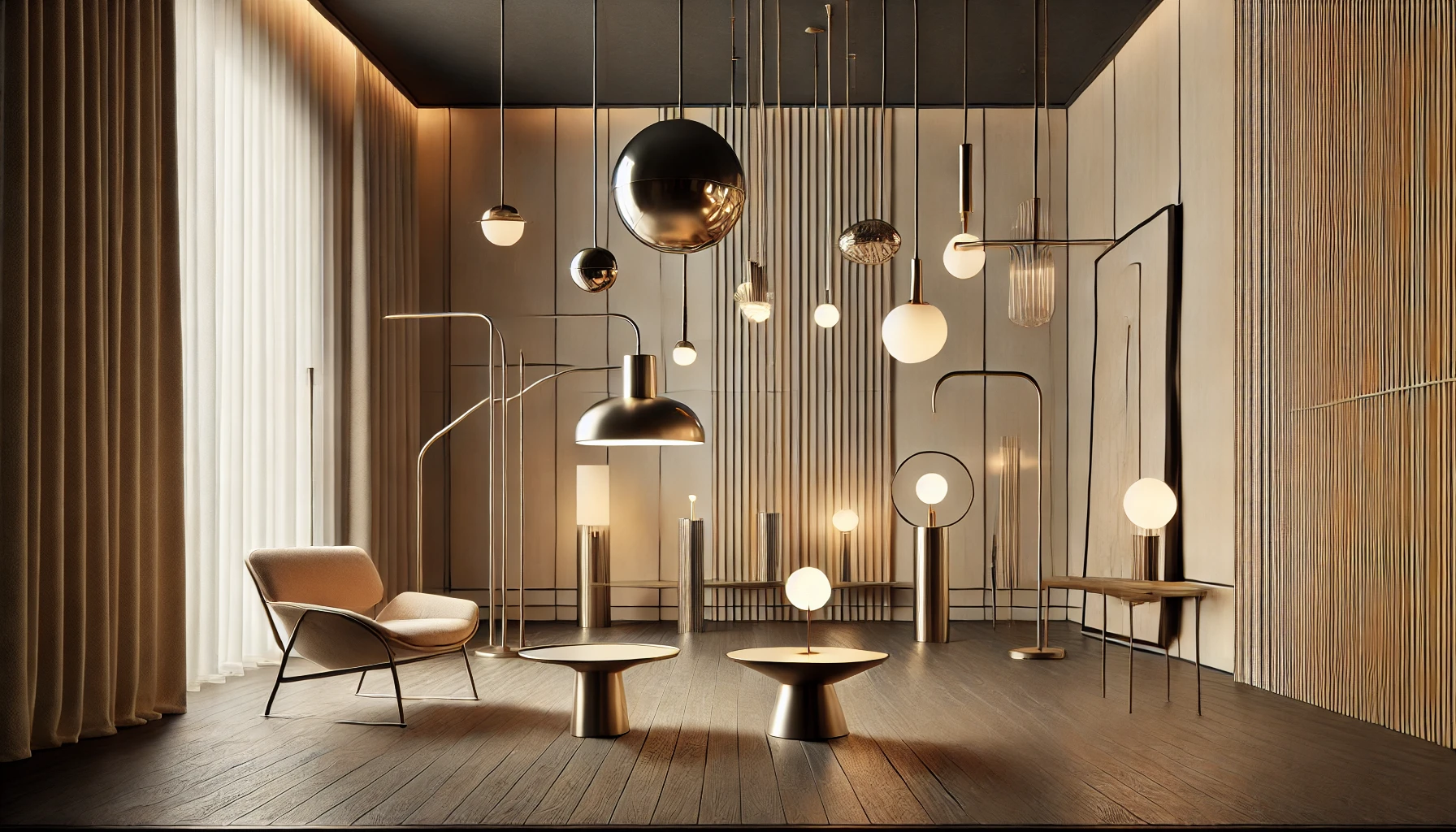
Pendant Lights and Chandeliers
Lighting plays a critical role in mid-century modern design, with pendant lights and chandeliers being popular choices. Look for fixtures with clean lines and geometric shapes, made from materials like metal and glass.
Pendant lights can serve as a focal point in the room, adding both function and style. Chandeliers, particularly those with a minimalist design, can bring a touch of elegance to any space.
Floor and Table Lamps
Floor and table lamps are also essential in mid-century modern design. Choose lamps with sleek, streamlined designs that complement the overall aesthetic of the room. A tripod floor lamp or a sculptural table lamp can be both functional and visually appealing.
The key is to keep the lighting simple and understated while still adding character to the space. Lighting should enhance the overall design without overpowering it.
Mid-century Modern Dining Room Ideas
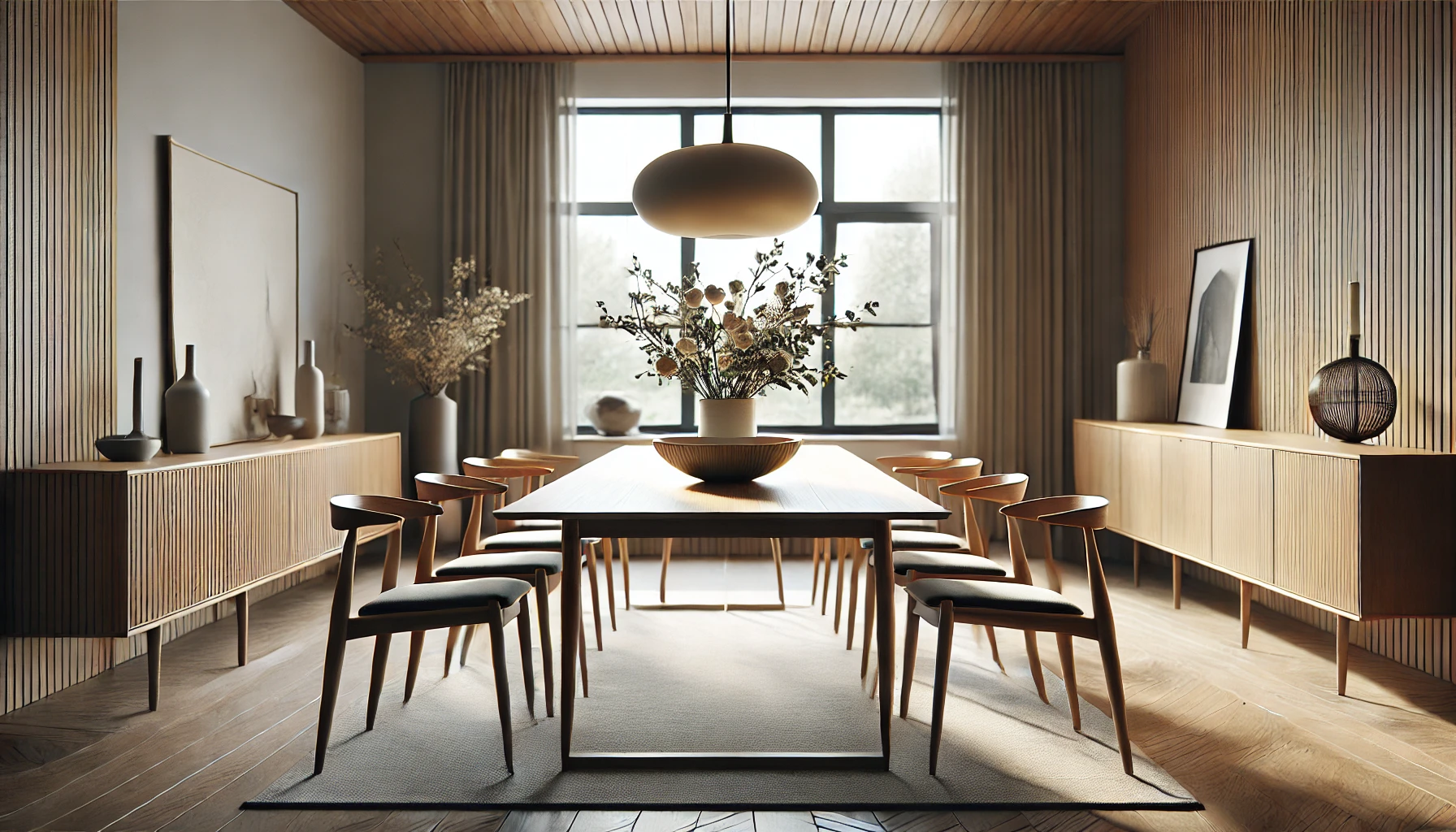
Choosing a Dining Table
The dining table is the centerpiece of any mid-century modern dining room. Look for a table with clean lines and tapered legs, preferably made from natural wood. A round or oval table works well in smaller spaces, while a rectangular table is ideal for larger dining areas.
Pair the table with minimalist chairs in matching wood tones or with sleek metal frames. The goal is to create a cohesive look that is both functional and stylish.
Accessorizing Your Dining Room
Accessories in the dining room should be minimal but impactful. Consider adding a statement centerpiece, such as a ceramic bowl or a vase with fresh flowers. Mid-century modern design emphasizes simplicity, so avoid overcrowding the table with unnecessary items.
Lighting in the dining room should also be considered carefully. A pendant light or chandelier above the dining table can create the perfect ambiance for meals, enhancing both the functionality and style of the space.
Mid-century Modern Office Design
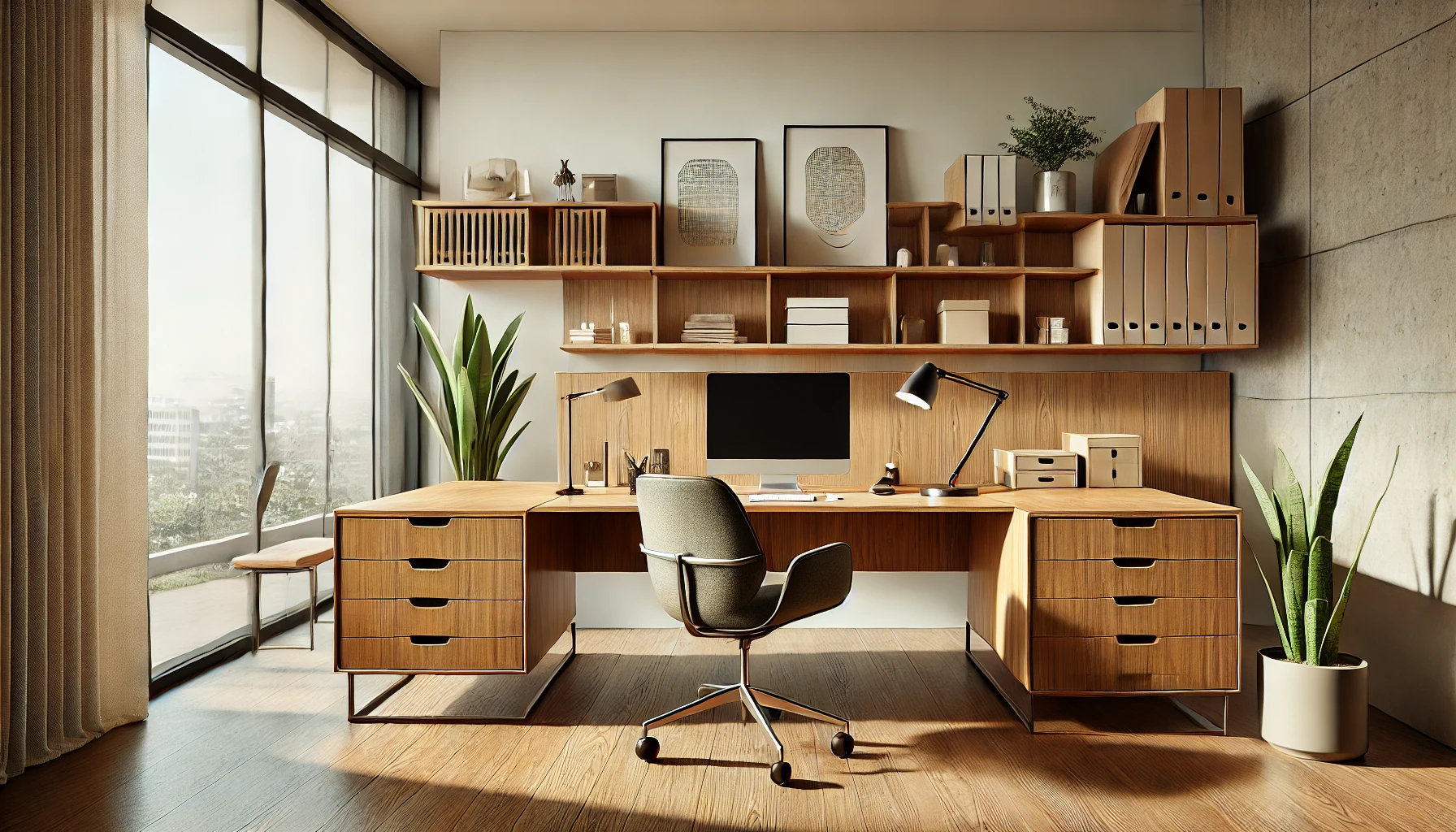
Functional and Stylish Desks
A mid-century modern office should be both functional and stylish. Start with a simple, streamlined desk made from wood or metal. The desk should have clean lines and minimal ornamentation, staying true to the mid-century modern aesthetic.
Pair the desk with an ergonomic chair that complements the overall design. Mid-century modern chairs are known for their comfort and style, making them the perfect addition to any office space.
Organizing Your Office Space
Organization is key in a mid-century modern office. Keep the workspace clutter-free by using minimalist storage solutions like floating shelves or simple filing cabinets. The goal is to maintain a clean and efficient workspace that promotes productivity.
Incorporating plants and natural light can also enhance the overall design of the office. A few well-placed plants can bring a touch of nature into the space, while large windows help to brighten the room and create a more inviting atmosphere.
Affordable Mid-century Modern Furniture
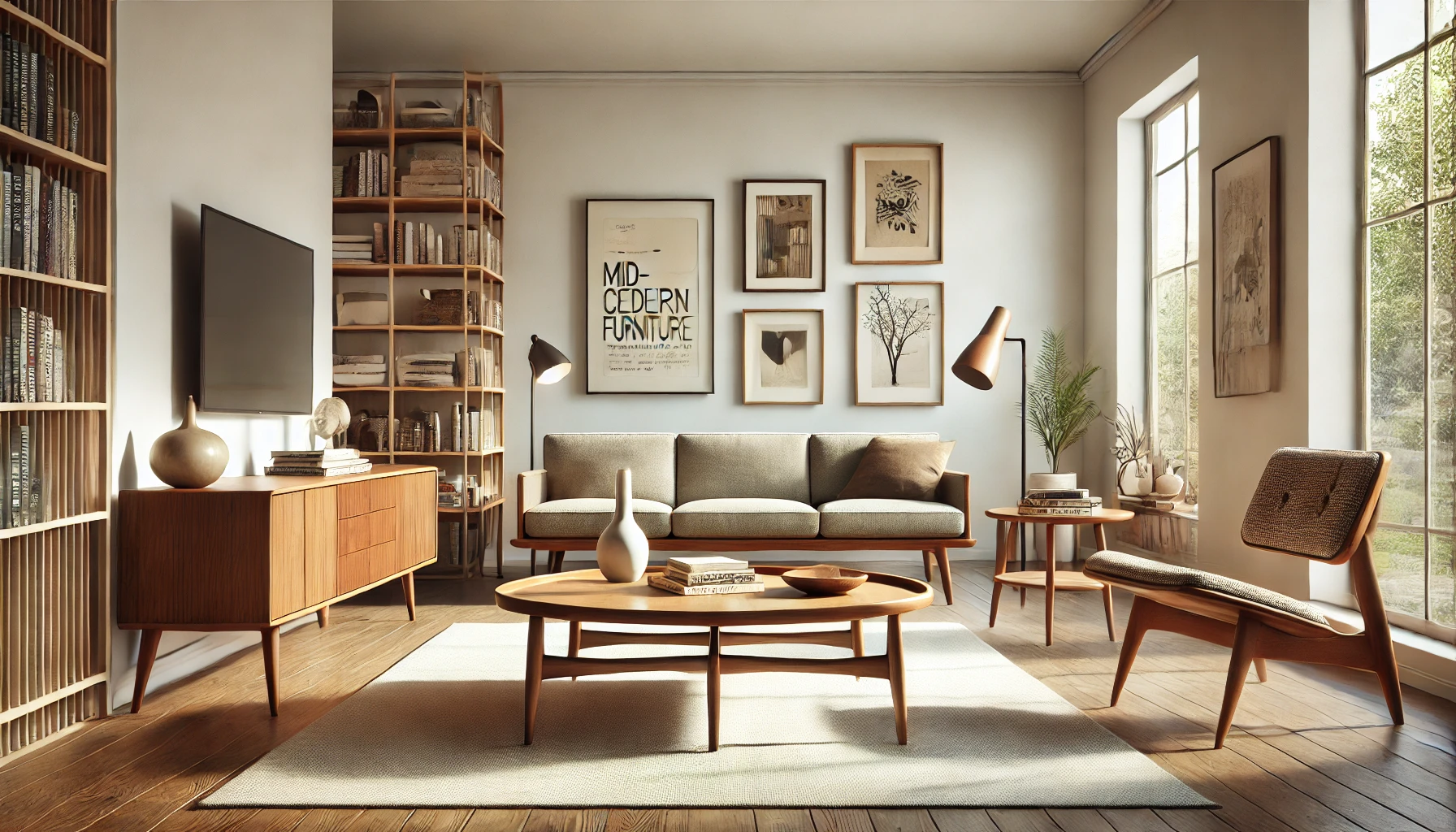
Finding Budget-friendly Mid-century Pieces
One of the common misconceptions about mid-century modern furniture is that it has to be expensive. In reality, there are plenty of affordable options for homeowners looking to incorporate this style into their space. Many retailers offer budget-friendly reproductions of classic mid-century designs, allowing you to capture the look without breaking the bank.
Second-hand stores and online marketplaces like eBay or Craigslist can also be great places to find authentic mid-century furniture at a lower cost. With a bit of patience and research, you can discover hidden gems that fit both your budget and your style.
DIY Mid-century Modern Furniture Ideas
If you’re feeling crafty, you can even create your own mid-century modern furniture. Many DIY enthusiasts have successfully built simple pieces like coffee tables or bookshelves using affordable materials such as plywood or recycled wood. There are numerous tutorials and guides available online to help you get started.
Not only is DIY a budget-friendly option, but it also allows you to customize your furniture to suit your space perfectly. With a bit of creativity, you can achieve the mid-century look without spending a fortune.
Mid-century Modern Design Elements
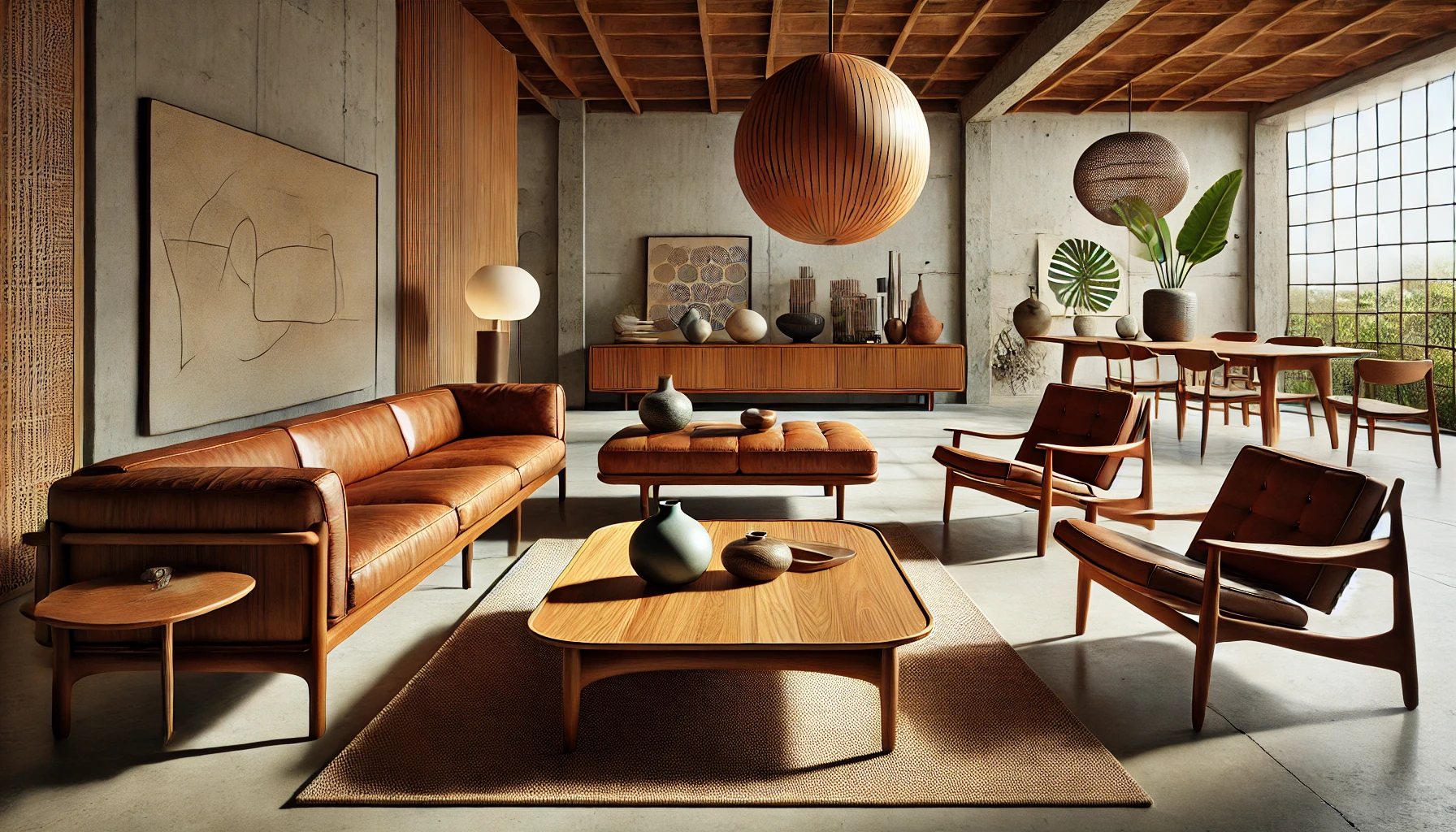
Iconic Materials and Textures
Mid-century modern design is characterized by the use of natural materials such as wood, metal, and leather. These materials add warmth and texture to the clean lines of the furniture. Teak and walnut are two popular wood choices in mid-century modern furniture, known for their durability and rich tones.
Incorporating these materials into your home can help you achieve an authentic mid-century look. Whether you’re choosing furniture or accessories, focus on natural textures and high-quality materials to stay true to this timeless style.
The Role of Geometry in Mid-century Design
Another key design element in mid-century modern interiors is the use of geometric shapes. From furniture to decor, sharp angles and clean lines are a hallmark of this design style. Whether it’s a rectangular coffee table or a circular rug, geometric elements add structure and interest to any room.
These shapes are often balanced by organic curves, which soften the overall look. This blend of geometric and organic forms is what makes mid-century modern design so visually striking and enduringly popular.
Mid-century Modern House Plans
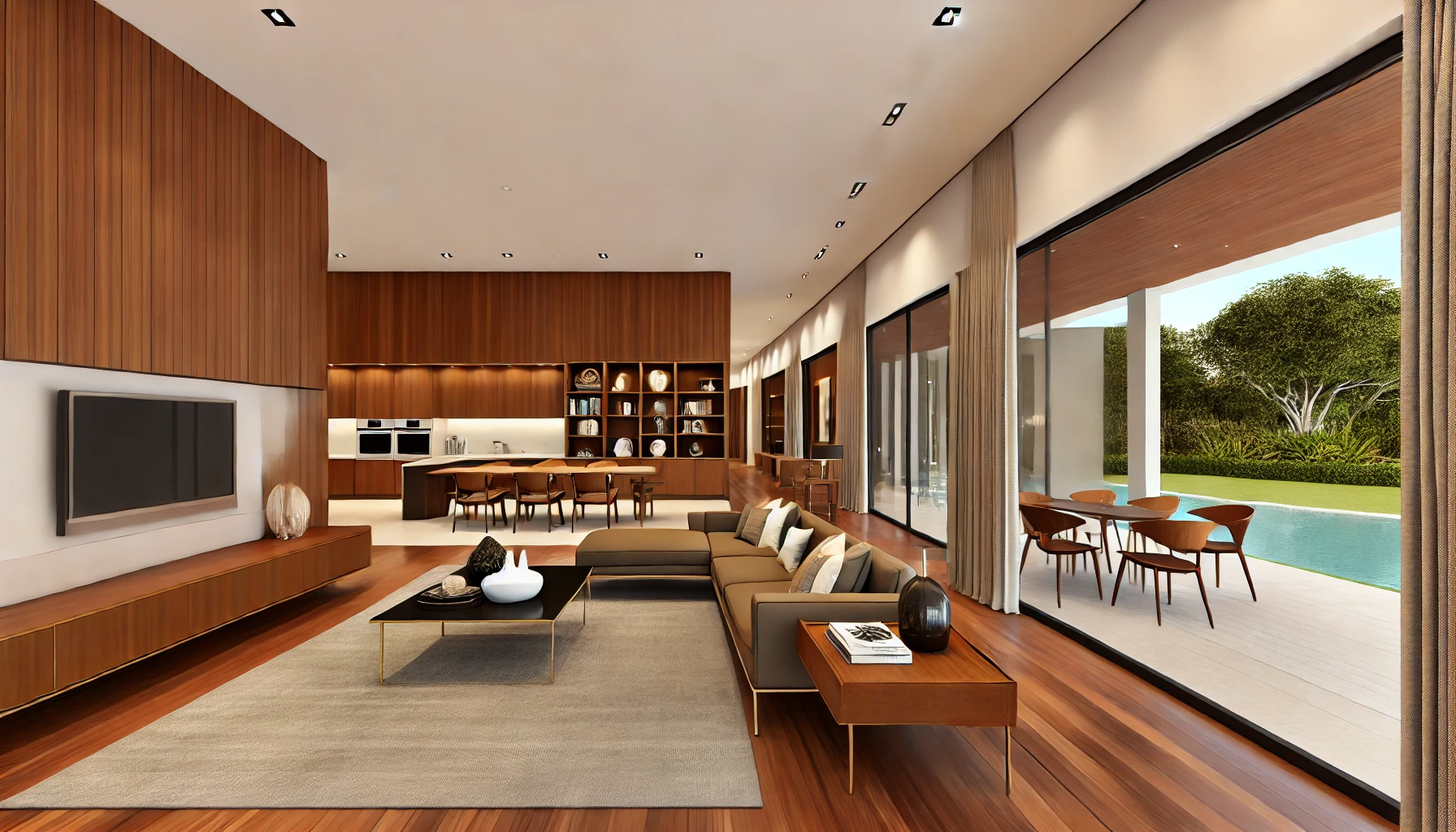
Open-concept Living Spaces
Mid-century modern homes are known for their open-concept floor plans, which allow for a seamless flow between different areas of the house. This design concept eliminates unnecessary walls, creating an airy and spacious environment that encourages movement and interaction.
Open-concept homes often feature large windows, allowing plenty of natural light to fill the space. This not only enhances the overall aesthetic but also creates a connection between the indoors and outdoors, a key principle in mid-century modern architecture.
Efficient Use of Space
Another defining feature of mid-century modern house plans is the efficient use of space. These homes are designed to be functional, with every square foot serving a purpose. Built-in furniture, such as shelving or benches, is a common feature that maximizes space without cluttering the room.
This emphasis on functionality extends to the home’s layout, with a focus on creating practical living spaces that are easy to navigate. Whether you’re building a new home or renovating an existing one, mid-century modern principles can help you create a stylish and efficient space.
Mid-century Modern Style Tips
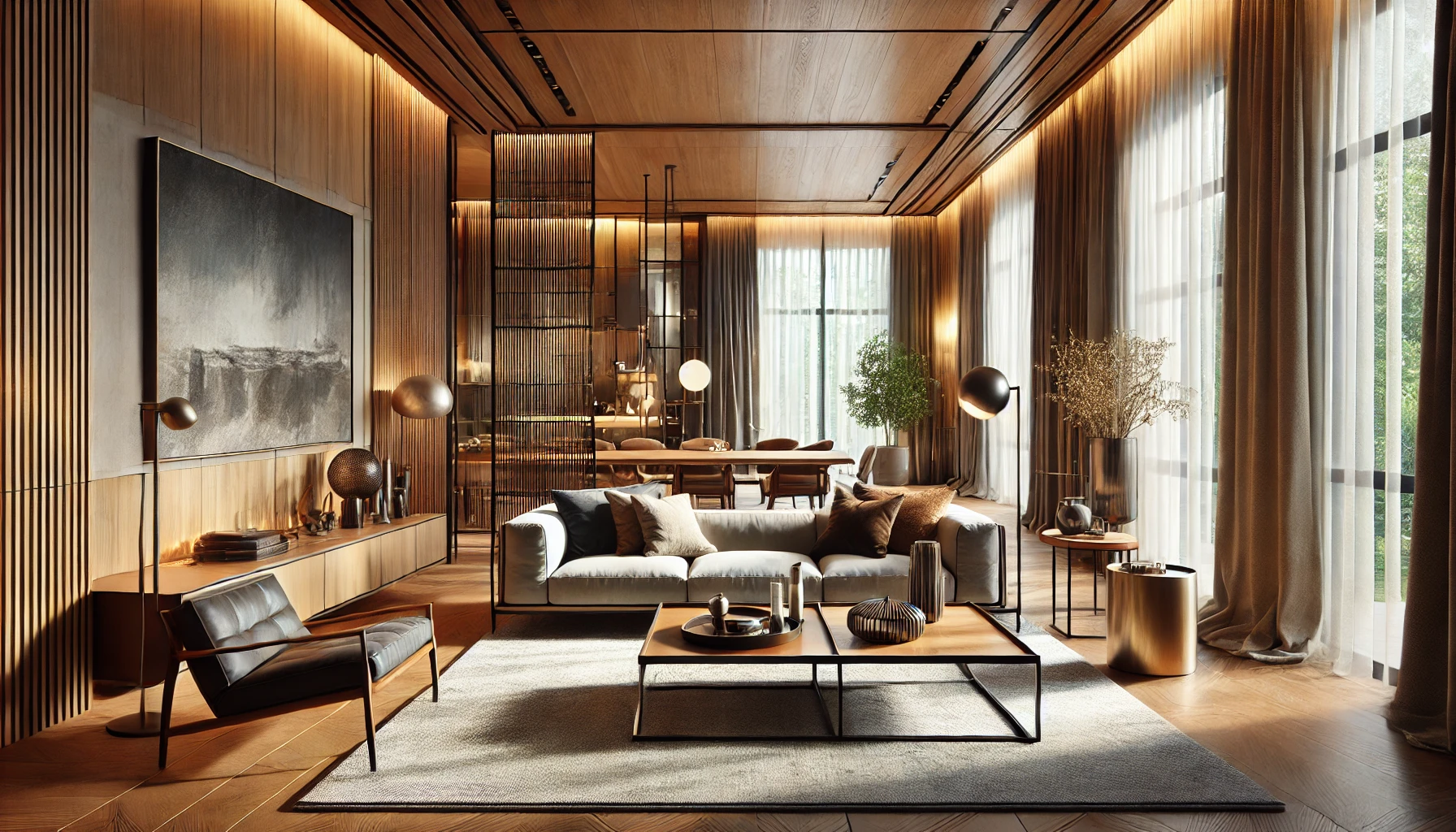
How to Mix and Match Mid-century with Other Styles
One of the great things about mid-century modern design is its versatility. It pairs well with other design styles, making it easy to mix and match. Whether you’re blending mid-century with contemporary, industrial, or Scandinavian elements, the key is to maintain balance.
Start by choosing a few signature mid-century pieces, such as a sofa or coffee table, and then layer in elements from other styles. The clean lines and minimalist aesthetic of mid-century modern design make it easy to integrate into almost any space.
Accessorizing with Mid-century Accents
Accessories are an important part of any mid-century modern home. To keep the look cohesive, focus on simple, geometric designs in your choice of decor. Throw pillows, vases, and clocks in bold colors or abstract shapes can add a touch of mid-century flair without overwhelming the space.
Lighting is also a key accessory in mid-century design. Opt for pendant lights, floor lamps, or sconces with clean lines and metallic finishes to complete the look. These small touches can make a big difference in creating a cohesive and stylish space.
Mid-century Modern Decor Accessories
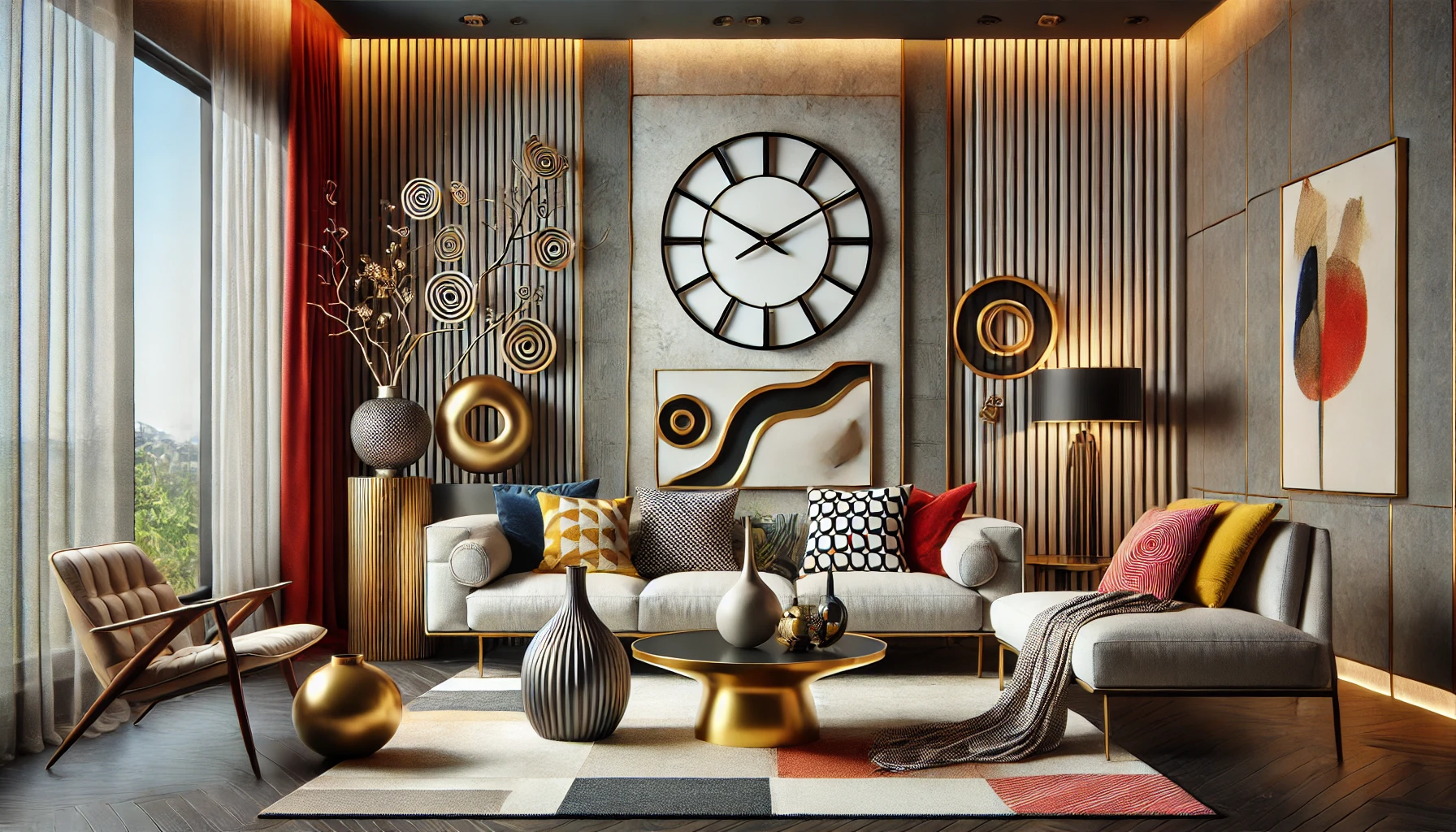
Choosing Statement Pieces
When it comes to mid-century modern decor, less is more. Choose a few standout accessories that reflect the clean lines and organic shapes of the style. A bold wall clock, an abstract art piece, or a sculptural vase can serve as the perfect finishing touch to any room.
These accessories should complement the furniture without overshadowing it. Stick to simple designs and avoid cluttering the space with too many items. A well-chosen accessory can elevate the entire room and bring your mid-century modern vision to life.
Balancing Color and Texture in Decor
Mid-century modern decor accessories are often used to introduce color and texture into a space. Throw pillows, rugs, and curtains in bold patterns or bright colors can add interest to an otherwise neutral room. These accessories allow you to play with the mid-century color palette while maintaining the overall simplicity of the design.
By carefully balancing color and texture, you can create a dynamic and inviting space. Just remember to keep it minimal—mid-century modern design is all about striking the perfect balance between form and function.
Embrace the Timeless Charm of Mid-century Modern Design
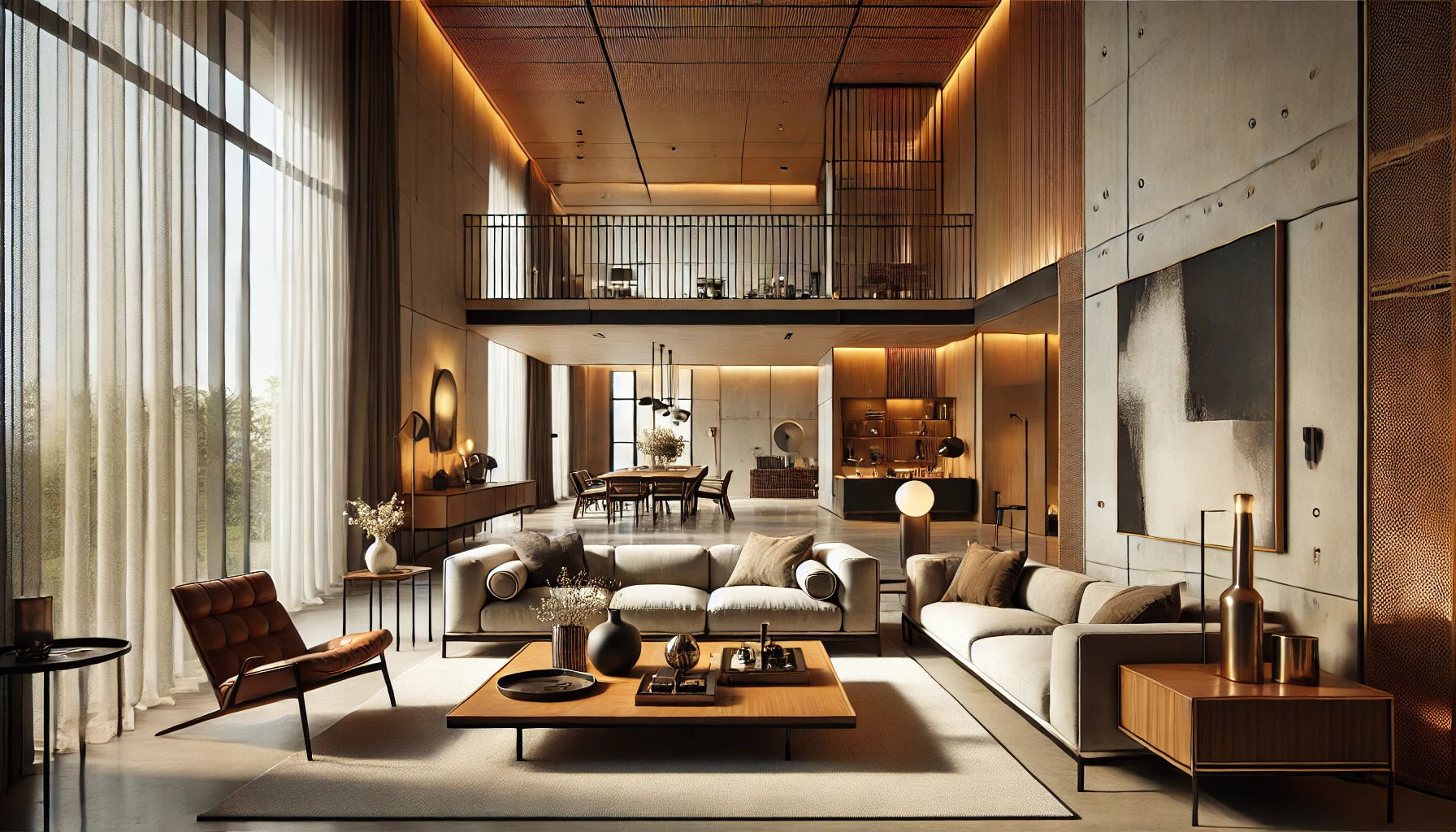
Mid-century modern design is more than just a trend; it’s a timeless style that continues to inspire homeowners and designers alike. By incorporating key elements like clean lines, natural materials, and functional furniture, you can create a space that is both stylish and practical. Whether you’re updating a single room or your entire home, mid-century modern design offers endless possibilities. Its versatility and appeal make it a favorite among those looking for a blend of form and function. So why wait? Start transforming your space today with the classic charm of mid-century modern design.
Incorporating mid-century modern elements into your home is not only a great way to elevate your living space but also an opportunity to express your personal style. From furniture to decor, every detail matters. So take the plunge, and let mid-century modern design inspire your next home makeover. You’ll be amazed at how this timeless style can transform your home into a modern, functional, and beautiful living space.
F.A.Q: Mid-century Modern Design
What is the history of Mid-century modern design?
Mid-century modern design emerged in the mid-20th century, roughly between the 1930s and 1960s. It is influenced by the post-war optimism, and its clean lines, simplicity, and functional aesthetic make it timeless.
How can I identify Mid-century modern furniture?
Mid-century modern furniture is characterized by its clean lines, geometric shapes, tapered legs, and minimal ornamentation. Common materials include wood, metal, and glass, often combined in sleek and functional designs.
What are the key characteristics of Mid-century modern design?
Key characteristics include simplicity, functionality, natural materials, clean lines, geometric shapes, and an emphasis on bringing the outdoors in through large windows and open spaces.
Is Mid-century modern design still popular today?
Yes, Mid-century modern design remains popular today due to its timeless appeal and versatility. Its minimalist aesthetic blends well with other design styles, making it a favorite for both homeowners and designers.
What materials are commonly used in Mid-century modern design?
Common materials include wood (especially teak and walnut), metal, leather, glass, and plastic. These materials are often combined to create functional, sleek, and durable furniture pieces.
How do I decorate my living room in Mid-century modern style?
To decorate your living room in Mid-century modern style, focus on simple furniture with clean lines, neutral colors, and geometric shapes. Add pops of color with decor like throw pillows, rugs, and wall art, and use natural materials like wood and leather.
What color palette is typical for Mid-century modern design?
The typical color palette includes neutral tones like beige, white, and gray, often accented with bold colors such as mustard yellow, olive green, and burnt orange. These colors create a balance of warmth and vibrancy.
What lighting works best in Mid-century modern interiors?
Pendant lights, arc lamps, and chandeliers with clean lines and geometric shapes are ideal for Mid-century modern interiors. Look for fixtures made from materials like metal and glass to complement the aesthetic.
What are some affordable ways to incorporate Mid-century modern design?
You can incorporate Mid-century modern design on a budget by choosing reproduction furniture, shopping second-hand, or using DIY techniques. Focus on key pieces like a coffee table or chairs, and accessorize with simple decor items.
What are some common mistakes to avoid in Mid-century modern design?
A common mistake is over-decorating. Mid-century modern design values simplicity and minimalism, so avoid clutter and stick to clean lines and functional furniture. Another mistake is using too many bold colors—balance is key.
Can Mid-century modern design work in small spaces?
Yes, Mid-century modern design works well in small spaces due to its focus on functionality and simplicity. Furniture pieces are often compact and multi-functional, making it perfect for maximizing smaller areas.
What are the most iconic Mid-century modern furniture pieces?
Some iconic Mid-century modern pieces include the Eames Lounge Chair, the Noguchi Coffee Table, and the Egg Chair. These designs are timeless and remain popular in contemporary interiors.
How does Mid-century modern design incorporate nature?
Mid-century modern design emphasizes bringing the outdoors in through the use of natural materials, large windows, and open floor plans that create a seamless transition between indoor and outdoor spaces.
Can I mix Mid-century modern with other design styles?
Yes, Mid-century modern pairs well with other design styles such as Scandinavian, contemporary, or industrial. The key is to maintain balance and choose complementary furniture and decor elements.
How do I maintain a Mid-century modern home?
To maintain a Mid-century modern home, focus on keeping the space clean and clutter-free. Regularly dust wooden furniture, polish metal fixtures, and keep textiles like rugs and cushions fresh to retain the style’s minimalist charm.
 Home Designing Get expert home decor tips and design inspiration at HomeDesigning.blog. Transform your living spaces with trending styles and DIY ideas!
Home Designing Get expert home decor tips and design inspiration at HomeDesigning.blog. Transform your living spaces with trending styles and DIY ideas!
